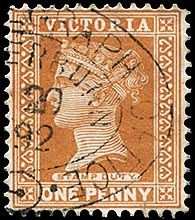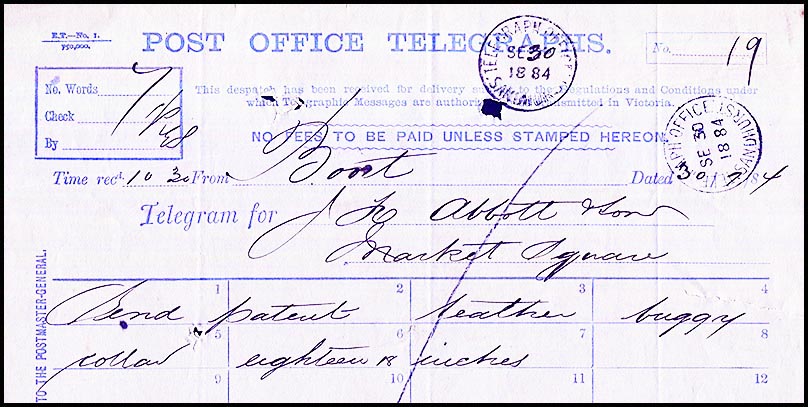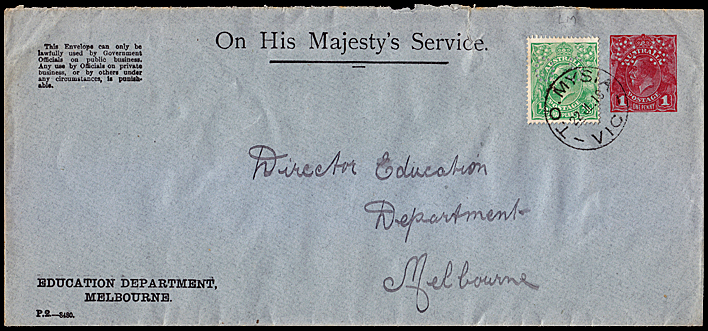Telegraph offices on the Wycheproof line.
- Australia 1901-1988
- New South Wales
- Overview of NSW
- Telegraph lines
- Telegraph Offices
- Date stamps
- Forms
- Envelopes
- Instructional annotation
- Collect
- Delayed
- Free
- Immediate Urgent
- Reply paid
- Rates
- Stamps
- 1871 Telegraph stamps
- 1885 proposal
- 1893 proposal
- Queensland
- South Australia
- Tasmania
- Victoria
- Western Australia
- International
- Special aspects
The following Telegraph Offices are included on this page:
| Barakee.
The Telegraph Office opened at the Railway Station in January 1884. No use of a telegraph form or envelope is recorded for Barakee. |
||
A T.O. Barrakee date stamp was issued for use with telegrams.
|
 9 January 1935. |
 3 October 1937. |
 23 September 1940. On piece. |
||
| Boort.
The Telegraph Office was opened in July 1883 at the Railway Station with a separate Telegraph office opening in conjunction with the Post Office in May 1884. The Belt and Buckle date stamp below is the earliest evidence of the Telegraph Office operating at Boort - no telegram is recorded with a early Boort date stamp. |
|
| Early forms:
The earliest indication of the operation of the Boort Telegraph Office is a message on a telegram delivery form (VC-DO-11B) at Sandhurst on 30 September 1884 from Boort - hence 2 - 3 months after the Boort Telegraph Office became operational. |
|
| Date stamps.
The Office was issued with a 1 hole Belt & Buckle date stamp. |
|
Used in black: 21 August 1891 to 19 October 1891 |
 21 August 1891 (earliest recorded date). Provenance: Hugh Freeman, Johnstone. |
|
The Bendigo Advertiser of 29 December 1876 reported "We hear that a petition, signed by J. Horwood, J. S. Robertson, J.P. and most of the influential farmers and men of business in and around Bridgewater, is about being forwarded to the proper authorities, in order to have a telegraph office established at that place. The amount of traffic (both passenger and goods) to Bridgewater renders the want of telegraphic communication a very great inconvenience. We believe Mr. Robertson has asked Mr. Thompson Moore, M.P., to present the petition to the Postmaster General, and to use his influence in meeting the wishes of the inhabitants of Bridgewater". The Gazette of 15 June 1877 noted that the line of electric telegraph had been extended from Inglewood to Bridgewater-on-Loddon (probably in the first week of June). The Bendigo Advertiser of 18 July 1877 reported: "The new Post and Telegraph office at Bridgewater, attached to the railway station, is now in full swing, the courtesy and attention of Miss. Hutchinson giving great satisfaction. Not withstanding this however, the residents, with good cause, are still dissatisfied - there being no letter delivery nor telegraphic messenger. When a telegram arrives, it remains at the office until the person for whom it is intended happens to call there. A gentleman there, living on the opposite side of the river, had a telegram waiting for him a day and a half. Without a messenger, the telegraph office is almost useless". The same newspaper of 10 September 1877 reported that Emily Hutchinson had been appointed Distributor of Stamps for Bridgewater-on-Loddon. The Bendigo Advertiser of 25 April 1889 reported that "The Postmaster-General, in answer to an inquiry by Mr. J. M. Highett, M L A., informs him that land has been purchased at Bridgewater as a site for a Post and Telegraph Office and the Public Works department has been requested to prepare plans for the proposed building". No special date stamp for use with telegraphs was issued to the office. |
| Charlton.
The Australasian of 21 July 1877 reported that the Postmaster-General had met a deputation from East Charlton "asking to grant a sum of £600 for the erection of a Post and Telegraph office at East Charlton. Mr. Cuthbert said there was no money available for the purpose at present but he promised to take the matter into consideration". Telegraphic connection was established with East Charlton in January 1878. In February 1879, a poll was taken at East Charlton as to the site of the new Post and Telegraph Office. "Instructions have been given for tenders to be called for the erection of the buildings upon the original site purchased by the Government, which obtained the preference of tbe inhabitants by a majority of 44 votes to 20." An office was opened at the Railway Station in July 1883. |
|
On 7 May 1880, the Bendigo Advertiser gave the following description: "Charlton, the temporary terminus of the proposed railway line if not carried on to Wentworth on the Murray, is an important agricultural township situated on the banks of the river Avoca and contains in or about 800 inhabitants. In it there are two flour mills, always kept fully employed, two branch banks, one of the Bank of Victoria, the other of the Bank of New South Wales, a court-house, Post and Telegraph office and Savings' Bank, literary institute and reading room, large numbers of first-class hotels, general stores, saddleries, butchers' shops, private residences and a foundry. Some of the public and the private buildings of Charlton lay claim to architectural beauty. The Bank of Victoria, for instance, is a large well-constructed building, and would be a credit to any up-country town. The Post and Telegraph office is likewise a handsomely constructed brick building. The flour mills are each built of brick and occupy a prominent position in the town. King's Hotel is perhaps the next best building after the banks and the Post Office. It is fitted up with every convenience of a modern hotel. The population round Charlton is purely agricultural". |
|
| Early forms:
The earliest indication of the operation of the Charlton Telegraph Office is the Belt & BUckle date stamp shown below. That was four and a haly years after the Office had opened. The earliest telegram for Charlton is a Reply-Paid message received at Sandhurst on 8 February 1886 from Charlton and copied onto a telegram delivery form (VC-DO-11B) . |
|
| Date stamps.
Charlton was the 5th Office to be issued with a 1 hole Belt & Buckle date stamp. No other date stamp is known for Charlton for use with telegraphs. |
|
|
 26 July 1882 (earliest recorded date). |
|
On 10 May 1871 the Bendigo Advertiser reported on the proceedings of the Eaglehawk Borough Council - in particular "From J. J. Casey, M.L.A., stating that he would urge the claim of Eaglehawk to a postal delivery and telegraph office. Received, the Mayor stating in reply to Cr. Avery, that Mr. T. Moore, M.L.A. had also taken action in the matter". A five mile line was constructed as a branch line from Sandhurst in 1871 and a Telegraph Office opened in October. Telegraph facilities were also made available to the public at the Railway Station from 21 June 1882. |
|
| Glenalbyn.
The Post Office was established at Glenalbyn Railway Station on 12 January 1886. It was renamed Glenalbyn Telegraph Office about 1910. The office was closed on 31 January 1973. |
|
A T.O. Glenalbyn date stamp was issued to the office:
|
 13 August 1935. |
|
|
|
|
|
|
|
The Telegraph Office opened at the Railway Station in November 1884. |
|
Telegraph facilities were made available to the public at the Railway Station from 25 May 1882. A Post Office was opened in May 1879. |
The office was issued with a T.O. datestamp: Used during the Telegraph Office period:
|
 30 August 1912. About 10 months after opening at the Railway Station. |
 T.O. Mysia in black. 22 June 1914. |
| Used during the Post Office only period: | ||
|
||
 22 July 1919. Detail from the cover above. |
||
|
 14 August 1924 (early usage). On 1/- Kangaroo on Map attached to a telegram piece. Rated: R. |
 20 February 1926. |
|
|
 28 December 1957. Late usage. |
|
||
| Wedderburn.
The Telegraph Office at Wedderburn was opened in early February 1876. Until 1858, the town was known as Korong. A Telegraph Office was opened nearby at the Wedderburn Road Railway Station in January 1884. Other telegraph Offices were opened at Wedderburn Junction R.S. and Wedderburn R.S. about 1910. They closed in 1911 and 1916 respectively. On 7 May 1880, the Bendigo Advertiser gave the following description: "Wedderburn is an important township, having at present a population of or about 1,000 inhabitants, irrespective of its immediate surroundings. There are in it two branch banks — one of the Bank of Australasia, the other of the Bank of Victoria. Seven hotels, twenty-five general stores, Post and Telegraph office and Savings Bank, Shire Hall and Council Chambers, Mechanics' Institute, containing 3,000 volumes of well assorted books, five churches, five establishments employing a considerable number of hands in the manufacture of farming implements, two saddler's shops, three schools — one of them being the State school, having an average attendance of 140 scholars; the other two private schools, each having a good average attendance, a police camp and court-house, large flour mill, giving employment to a considerable number of hands, six butchers' shops, and a large number of substantially constructed private residences". |
||
| Early forms:
The earliest (only) telegram for Wedderburn is a message received at Sandhurst in 1887 from Wedderburn and copied onto a telegram delivery form (VC-DO-11C) . |
||
The Office was issued with a 1 hole Belt & Buckle date stamp.
|
 20 June 1892. |
 20 ?? 1892. |
| Wycheproof.
The Telegraph Office was opened in September 1883 at the Railway Station when the rail line reached Wycheproof from Sandhurst via Inglewood and Charlton. The Post Office had a more difficult path. It had opened in 1873 but changed name to Mount Wycheproof on 1 September 1877. On 1 April 1884, it changed name to Moffat but, on the same day, changed to Mount Wycheproof. The area around the town was renamed Moffat in 1883. In September 1886, a deputation met the Postmaster-General to discuss a site for the Post and Telegraph Office at Wycheporoof. Two sites had been nominated from which one should be chosen and construction commenced immediately. The following year, on 27 December 1887, "An indignation meeting was held on Friday evening to protest against the dilatoriness of the Public Works department in accepting tenders for the Post and Telegraph Office, the same having been invited six months ago. Resolutions were passed that the Government be asked to at once proceed with the work" |
||
Personnel: 1888: Constable Beresford of Taradale, tendered his resignation as Inspector of Nuisances on account of his removal to Wycheproof. |
||
| Early forms:
The earliest indication of the operation of the Wycheproof Telegraph Office is a message on a telegram delivery form (VC-DO-11B) received at Sandhurst on 12 February 1886 from Wycheproof. |
||
| The Office was issued with a Belt & Buckle date stamp which was used in at least two if not three formats. | ||
|
||
|
 24 June 1892. On a Parcel Bill. |
 4 July 1892. Detail from the form shown below. |
|
||
|
 6 May 1890 (earliest recorded date). |
 23 June 1890. |








